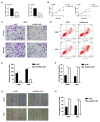LncRNA RUSC1-AS1 promotes osteosarcoma progression through regulating the miR-340-5p and PI3K/AKT pathway
- PMID: 34048366
- PMCID: PMC8436931
- DOI: 10.18632/aging.203047
LncRNA RUSC1-AS1 promotes osteosarcoma progression through regulating the miR-340-5p and PI3K/AKT pathway
Abstract
Dysregulation of long noncoding RNA (lncRNA) is frequently involved in the progression and development of osteosarcoma. LncRNA RUSC1-AS1 is reported to be upregulated and acts as an oncogene in hepatocellular carcinoma, cervical cancer and breast cancer. However, its role in osteosarcoma has not been studied yet. In the present study, we investigated the role of RUSC1-AS1 in osteosarcoma both in vitro and in vivo. The results showed that the expression of RUSC1-AS1 was significantly upregulated in osteosarcoma cell line U2OS and HOS compared to that in human osteoblast cell line hFOB1.19. Similar results were found in human samples. Silencing RUSC1-AS1 by siRNA significantly inhibited U2OS and HOS cell proliferation and invasion, measured by CCK-8 and transwell assay. Besides, knockdown of RUSC1-AS1 increased cell apoptosis in osteosarcoma cell lines. In addition, RUSC1-AS1 promoted the epithelial-mesenchymal transition (EMT) process of osteosarcoma cells. In vivo experiments confirmed that RUSC1-AS1 knockdown had an inhibitory effect on osteosarcoma tumor growth. Mechanically, we showed that RUSC1-AS1 directly binds to and inhibits miR-340-5p and activates the PI3K/AKT signaling pathway. In conclusion, our study demonstrated that RUSC1-AS1 promoted osteosarcoma development both in vitro and in vivo through sponging to miR-340-5p and activating the PI3K/AKT signaling pathway. Therefore, RUSC1-AS1 becomes a potential therapeutic target for osteosarcoma.
Keywords: PI3K/AKT; RUSC1-AS1; miR-340-5p; osteosarcoma.
Conflict of interest statement
Figures







Similar articles
-
Long noncoding RNA OIP5-AS1 causes cisplatin resistance in osteosarcoma through inducing the LPAATβ/PI3K/AKT/mTOR signaling pathway by sponging the miR-340-5p.J Cell Biochem. 2019 Jun;120(6):9656-9666. doi: 10.1002/jcb.28244. Epub 2018 Dec 11. J Cell Biochem. 2019. PMID: 30548308
-
Long noncoding RNA RUSC1-AS1 promotes tumorigenesis in cervical cancer by acting as a competing endogenous RNA of microRNA-744 and consequently increasing Bcl-2 expression.Cell Cycle. 2020 May;19(10):1222-1235. doi: 10.1080/15384101.2020.1749468. Epub 2020 Apr 8. Cell Cycle. 2020. PMID: 32264732 Free PMC article.
-
LncRNA FER1L4 induces apoptosis and suppresses EMT and the activation of PI3K/AKT pathway in osteosarcoma cells via inhibiting miR-18a-5p to promote SOCS5.Gene. 2019 Dec 30;721:144093. doi: 10.1016/j.gene.2019.144093. Epub 2019 Aug 29. Gene. 2019. PMID: 31473323
-
FoxD2-AS1 promotes glioma progression by regulating miR-185-5P/HMGA2 axis and PI3K/AKT signaling pathway.Aging (Albany NY). 2019 Mar 11;11(5):1427-1439. doi: 10.18632/aging.101843. Aging (Albany NY). 2019. Retraction in: Aging (Albany NY). 2023 Apr 14;15(7):2812. doi: 10.18632/aging.204664. PMID: 30860979 Free PMC article. Retracted.
-
Interplay between lncRNAs and the PI3K/AKT signaling pathway in the progression of digestive system neoplasms (Review).Int J Mol Med. 2025 Jan;55(1):15. doi: 10.3892/ijmm.2024.5456. Epub 2024 Nov 8. Int J Mol Med. 2025. PMID: 39513614 Free PMC article. Review.
Cited by
-
Screening and verification of prognostic lncRNA markers related to immune infiltration in the metastasis of osteosarcoma.Transl Cancer Res. 2022 Sep;11(9):3235-3249. doi: 10.21037/tcr-22-1926. Transl Cancer Res. 2022. PMID: 36237238 Free PMC article.
-
Bioinformatics Analysis of the Inflammation-Associated lncRNA-mRNA Coexpression Network in Type 2 Diabetes.J Renin Angiotensin Aldosterone Syst. 2023 Feb 22;2023:6072438. doi: 10.1155/2023/6072438. eCollection 2023. J Renin Angiotensin Aldosterone Syst. 2023. PMID: 36874406 Free PMC article.
-
Melatonin Repairs Osteoporotic Bone Defects in Iron-Overloaded Rats through PI3K/AKT/GSK-3β/P70S6k Signaling Pathway.Oxid Med Cell Longev. 2023 Jan 17;2023:7718155. doi: 10.1155/2023/7718155. eCollection 2023. Oxid Med Cell Longev. 2023. PMID: 36703914 Free PMC article.
-
Regulation of the Epithelial to Mesenchymal Transition in Osteosarcoma.Biomolecules. 2023 Feb 20;13(2):398. doi: 10.3390/biom13020398. Biomolecules. 2023. PMID: 36830767 Free PMC article. Review.
-
Anti-cancer targets and molecular mechanisms of formononetin in treating osteosarcoma based on network pharmacology.Aging (Albany NY). 2023 Oct 20;15(20):11489-11507. doi: 10.18632/aging.205139. Epub 2023 Oct 20. Aging (Albany NY). 2023. PMID: 37870753 Free PMC article.
References
-
- Martin-Broto J, Redondo A, Valverde C, Vaz MA, Mora J, Garcia Del Muro X, Gutierrez A, Tous C, Carnero A, Marcilla D, Carranza A, Sancho P, Martinez-Trufero J, et al.. Gemcitabine plus sirolimus for relapsed and progressing osteosarcoma patients after standard chemotherapy: a multicenter, single-arm phase II trial of Spanish Group for Research on Sarcoma (GEIS). Ann Oncol. 2017; 28:2994–99. 10.1093/annonc/mdx536 - DOI - PubMed
-
- Sobin LH, Gospodarowicz MK, Wittekind C. TNM classification of malignant tumours. 7th Edition.John Wiley & Sons; 2011.
Publication types
MeSH terms
Substances
LinkOut - more resources
Full Text Sources
Other Literature Sources
Molecular Biology Databases

